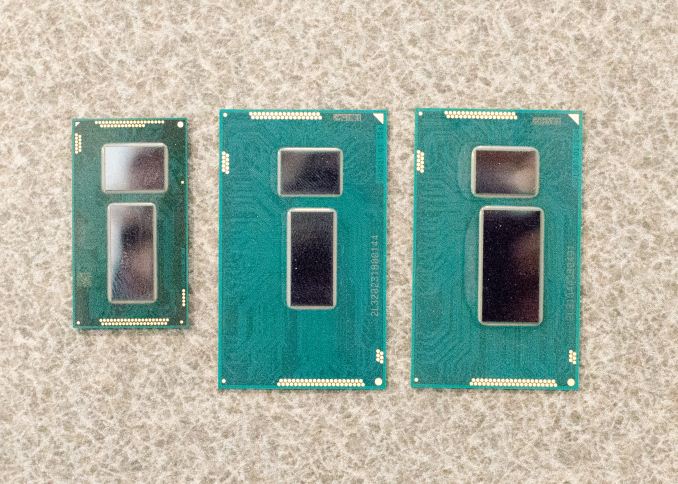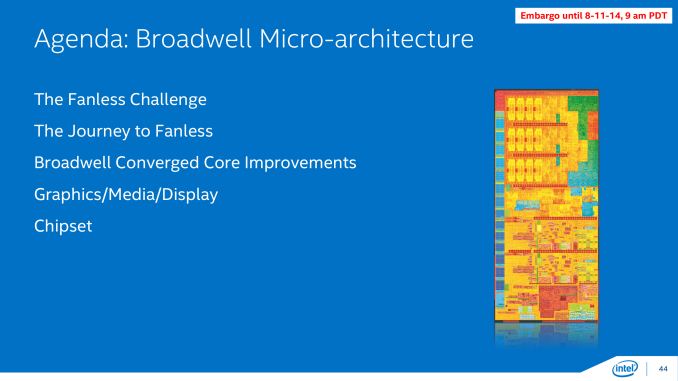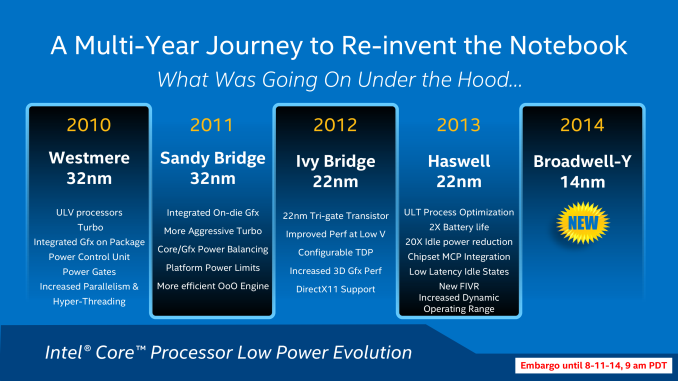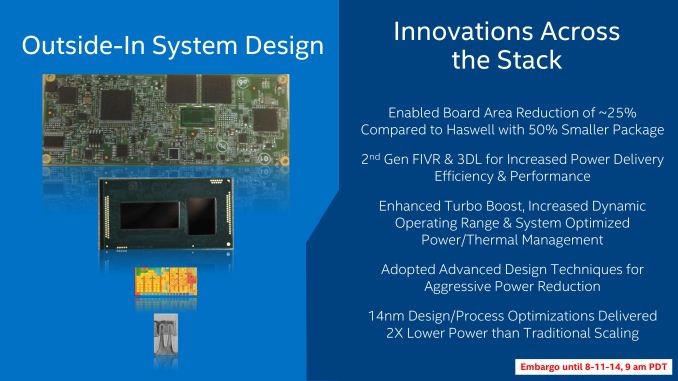Intel Broadwell Architecture Preview: A Glimpse into Core M
by Ryan Smith on August 11, 2014 12:01 PM EST
With Haswell Refresh fully behind us and 2014 now in to its second half, Intel is turning their attention to their next generation of products and processes. Intel’s tick-tock methodology coupled with the long development periods of new products means that the company has several projects in flight at any given time. So while we have seen the name Broadwell on Intel’s roadmaps for some time now, the reality of the situation is that we know relatively little about Intel’s next generation architecture and the 14nm process that it is the launch vehicle for.
Typically we would see Intel unveil the bulk of the technical details of their forthcoming products at their annual Intel Developer Forum, and with the next IDF scheduled for the week of September 9th we’ll see just that. However today Intel will be breaking from their established standards a bit by not waiting until IDF to deliver everything at once. In a presentation coinciding with today’s embargo, dubbed Advancing Moore’s Law in 2014, Intel will be offering a preview of sorts for Broadwell while detailing their 14nm process.
Today’s preview and Intel’s associated presentation are going to be based around the forthcoming Intel Core M microprocessor, using the Broadwell configuration otherwise known at Broadwell-Y. The reason for this is a culmination of several factors, and in all honesty it’s probably driven as much by investor relations as it is consumer/enthusiast relations, as Intel would like to convince consumer and investor alike that they are on the right path to take control of the mobile/tablet market through superior products, superior technology, and superior manufacturing. Hence today’s preview will be focused on the part and the market Intel feels is the most competitive and most at risk for the next cycle: the mobile market that Core M will be competing in.
To that end Intel’s preview is very much a preview; we will see bits and pieces of Broadwell’s CPU architecture, GPU architecture, and packaging, along with information about Intel’s 14nm process. However this isn’t a full architecture preview or a full process breakdown. Both of those will have to wait for Intel’s usual forum of IDF.
Diving into matters then, Core M will be launch vehicle for Broadwell and will be released for the holiday period this year. In fact Intel is already in volume production of the Broadwell-Y CPU and production units are shipping to Intel’s customers (the OEMs) to begin production and stockpiling of finished devices for the holiday launch.
Intel’s decision to initially focus Broadwell on the mobile market comes as the company takes the next step in their plan to extend into the Core processor series into these devices. Arguably, Intel has been slow to response to the rise of ARM devices, whose rapid rise has undercut traditional PC sales and quickly become the biggest threat to Intel’s processor dominance in some number of years. Intel is far from doomed right now, but even they see the potential farther down the line if they do not act.
Intel for their part has responded, but it has taken a step-by-step (multi-year) process that has seen the company progressively build smaller and less power hungry CPUs in order to fit the needs of the mobile market. Since Intel integrated their graphics on-die with Sandy Bridge in 2011, the company has continued to tweak the designs of their products, with Ivy Bridge and Haswell generation products introducing further optimizations and new manufacturing processes. Now on their latest iteration with Broadwell, the company believes they’re turning a corner and have the technology they need to be a leader in the high performance mobile market. It's important to note that despite Intel's best intentions here, Broadwell and Core M remain targeted at premium devices. You won't see these parts in cheap tablets. The duty of doing battle with ARM remains Atom's alone.
Many of these changes ultimately amount to boosting performance and reducing power consumption to a point where power and heat are where they need to be for mobile form factors, either through process efficiency improvements or through better power management and wider dynamic ranges – boosting where it matters and doing a better job of idling between tasks. However as Intel has discovered they not only need to be able to meet the TDP requirements of a tablet but they need to be able to meet the size requirements too. A particularly daunting task when the entire thickness of a device needs to be under 10mm, and the CPU thinner yet.
As a result, coupled with Core M’s performance improvements and power reductions is a strong emphasis on the size of the processor package itself and what Intel could do to reduce it. Intel calls this an outside-in system design, with various parts of Intel focusing on everything from the size of the logic board needed to hold the processor to the thickness of the processor die itself. In the following pages we’ll take a look at Intel’s efforts to get slim, but to kick things off we have a picture of Broadwell-Y from Computex 2014.

From left to right: Broadwell-Y (Core M), Broadwell ULT/ULX and Haswell ULT/ULX
Intel wants a greater foothold in the mobile market and they want it badly. And with Broadwell-Y they believe they finally have what they need to accomplish that goal.














158 Comments
View All Comments
psyq321 - Tuesday, August 12, 2014 - link
Actually, apart from power-users I fail to see any tangible improvements in performance of modern CPUs that matter to desktop/notebook usage, Intel or otherwise.In the mobile space, it is improvements in GPU which mattered, but even that will eventually flatten once some peak is reached since graphics improvements on 4" / 5" screen can only matter to wide audiences up to some point.
However, there are surely enough customers that do look forward to more power - this is workstation and server market. Skylake and its AVX512 will matter to scientists and its enormous core count in EP (Xeon) version will matter to companies (virtualization, etc.).
Standard desktop, not so much. But, then again, ever since Core 2 Quad 6600 this was the case. If anything, large-scale adoption of SSDs is probably the single most important jump in desktop performance since the days of Conroe.
Khenglish - Monday, August 11, 2014 - link
I find the reduction in die thickness to be a big deal. Maybe this will prevent temperatures from getting out of control when the cpu core area gets cut in half for 14nm. High power 22nm cpus already easily hit 30c temperature difference between the cpu and heatsink.AnnonymousCoward - Tuesday, August 12, 2014 - link
Probably not. I'd guess thermal dissipation is the same.dgingeri - Monday, August 11, 2014 - link
PC sales are down mostly because people can keep their systems longer due to the lack of innovation coming from Intel on desktop chips and the lack of utilizing the current CPU technology by software developers. They could be so much more, if only developers would actually make use of the desktop CPU capabilities for things such as a voice command OS that doesn't need to be trained. Intel would then have a reason to produce more powerful chips that would trigger more PC sales.As it is, the current processor generation is less than 10% faster clock for clock compared to three generations ago. A great many thing aren't any faster at all. Know what? It doesn't even matter because nothing uses that much power these days.
Tablets and smartphones can't take the place of full PCs for most people. Their screens are just too small. Perhaps the younger generations prefer the small form factors right now, but give them a little time, and their eyes won't let them use such things. I can see the move to laptops, especially with 14-15" screens, but trying to show the same content on a 10" screen is just near unusable, and a 5" smartphone screen is just downright impossible. However, desktop PCs still have their place, and that's never going to change.
This push by "investors" for the tablet and smartphone market is just asinine. Broadwell isn't going to help sales all that much. Perhaps, they might sell some more Intel based tablets, but it won't be all that much of an improvement. Tablets have a niche, but it really isn't that much of one.
HanzNFranzen - Monday, August 11, 2014 - link
Tablets are a niche and not much of one? lol yea ok... well while you were asleep in a cave, over 195 million tablets were sold in 2013 between Android/Apple/Microsoft which is just shy of 80 million more than the previous year. World wide PC sales totaled 316M units, so we are talking nearly 2 tablets for every 3 PC's sold. Eh...small niche...dgingeri - Monday, August 11, 2014 - link
yeah, lots of people have them, but how much do they really use them? I have two, one Android and one Windows RT, and I only use them for reading books or for reading the web news while away from home. The Windows unit showed promise, since I could use it to run Office and terminal programs, but I ended up not using it at work anymore because it couldn't use a USB to serial adapter for talking to switches and raid arrays. It ended up being only half useful. They're nice to have for certain things, but they aren't as versatile as a PC. My parents own two, and two PCs, and they use the PCs far more. My older sister has one, and she barely uses it. Her 7 year old uses it to play games most of the time. My nephew has one, and he's only ever used it to read Facebook. It's a telling tale that everyone I've known who has one only has limited used for it.mapesdhs - Monday, August 11, 2014 - link
Point taken, but if people are *buying* them, irrespective of whether they use them,then it doesn't really matter.
Besides, this whole field of mobile computing, smart phones, tablets, now phablets,
etc., it's too soon to be sure where we're heading long-term.
Many people say the copout porting of console games to PCs with little enhancement
is one thing that's harmed PC gaming sales. This may well be true. Now that the newer
consoles use PC tech more directly, perhaps this will be less of an issue, but it's always
down to the developer whether they choose to make a PC release capable of exploiting
what a PC can do re high res, better detail, etc. Wouldn't surprise me if this issue causes
internal pressures, eg. make the PC version too much better and it might harm console
version sales - with devs no doubt eager to maximise returns, that's something they'd
likely want to avoid.
Ian.
az_ - Monday, August 11, 2014 - link
Ryan, could you add a size comparison to an ARM SOC that would be used in a tablet? I wonder how close are Intel in size. Thanks.name99 - Tuesday, August 12, 2014 - link
BDW-Y is 82 mm^2. The PCH looks like it's about a third of that, so total is maybe 115 mm^2 or so.In comparison, Apple A7 is about 100 mm^2.
A7 includes some stuff BDW-Y doesn't, and vice versa, so let's call it a wash in terms of non-CPU functionality.
BDW-Y obviously can perform a LOT better (if it's given enough power, probably performs about the same at the same power budget). On the other hand it probably costs about 10x what an A7 costs.
Krysto - Tuesday, August 12, 2014 - link
Sure, also let's conveniently forget that Broadwell Y benefits not only of 3D transistors, but a 2 generation node shrink, too, compared to A7. Now put A7 on 14nm and 3d transistors...and let's see which does better.This is the issue nobody seems to understand, not even Anand, or just conveniently ignored it when he declared that the "x86 myth is busted". At the time we were talking about a 22nm Trigate Atom vs 28nm planar ARM chip, with Atom barely competing on performance (while costing 2x more, and having half the GPU performance). Yet Anand said the x86 bloat myth is busted...How exactly?! Put them on the same process technology...and then we'll see if x86 myth is indeed busted, or it's still bloated as a pig.